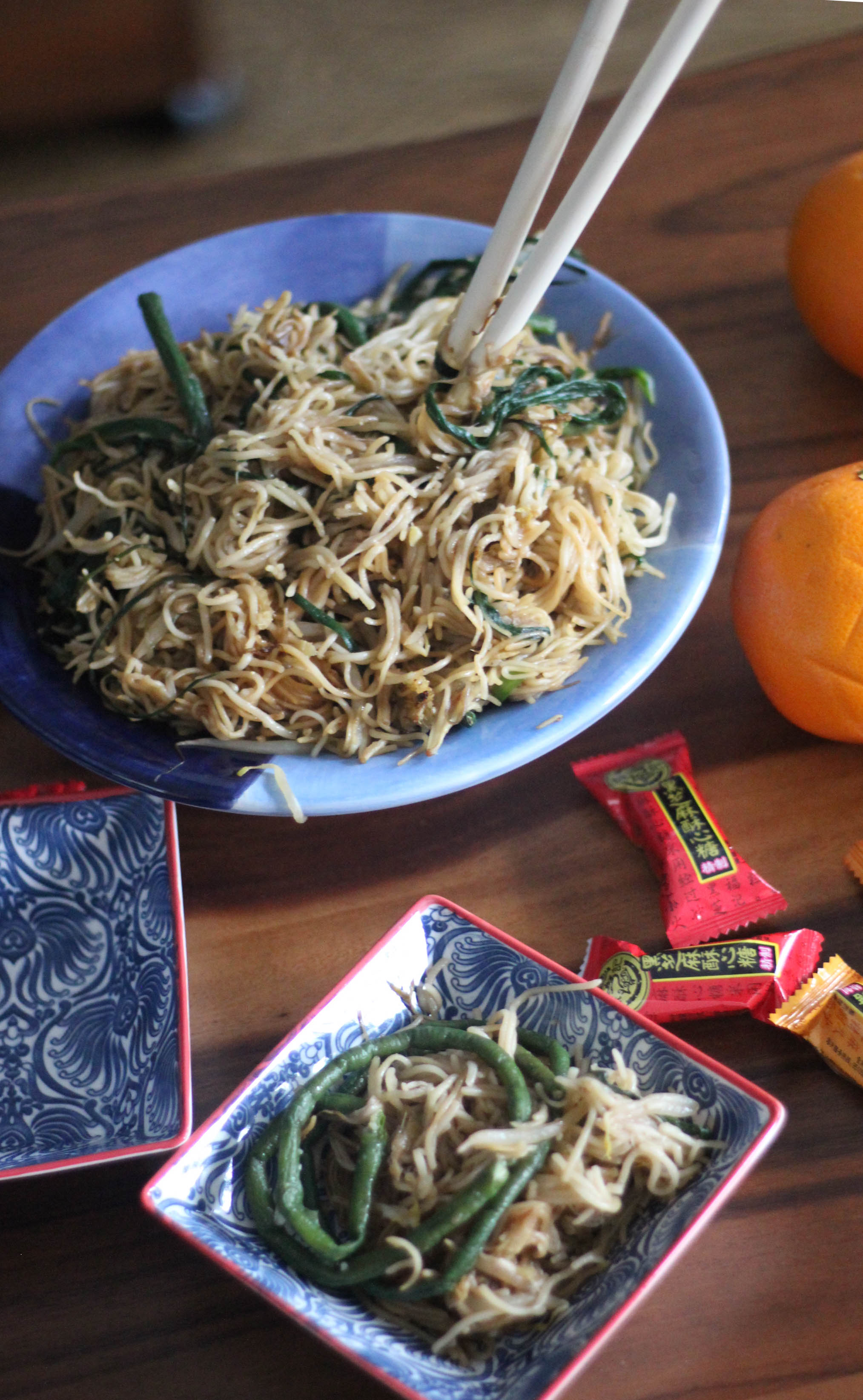Towards the end of any Chinese banquet -- a wedding, birthday, and most definitely Lunar New Year -- you will get a giant platter of noodles.
You’ll reach for your serving but the noodles won’t stop. They’re long and tangled. You look for a knife, but of course there aren’t any knives at a Chinese banquet table, just chopsticks. Not that your grandma would allow you to cut them. Aiya, do you want to cut your life short?
So you pull and pull and before you know it, your small chopstick pinch turns into an entire plateful.
These noodles aren’t just any noodles, they’re longevity noodles -- uncut and extra long. The long life symbolism and somewhat comical way you eat them got me thinking… what if all the ingredients in Longevity Noodles were long and uncut?
And so I added long beans, flat Chinese chives, enoki mushrooms, and bean sprouts. No stunted peas or diced anything -- we’re looking for length! I gave the veggies a little trim but otherwise kept them at full length.
When it comes to a long life, might as well quintiple down, right?
RECIPE
Note: Stir-fries are easy and very adaptable. All the work is in the prep. Cooking happens in a matter of minutes. The key to stir-frying is to time your ingredients and know how they cook. For example, of all the vegetables in this recipe, only the long beans and Chinese chives sear quickly. The mushrooms and bean sprouts are very watery and will steam before they brown, if they do so at all. So you have to decide what you want to sear and what you want to steam. If you want your ingredients to brown, you may have to cook them in batches so they have room to expel water and brown. Or, you can do as I did and only sear a couple of ingredients, and then add the rest of the watery ingredients to steam all together. This is technically more of a stir-fry/braise, but is equally delicious and a whole lot faster than a true stir-fry.
½ lb longevity noodles (Or any Asian wheat noodle. I like thinner noodles, but they are more prone to breaking which kinda happened here 😬)
1 ½ tbsp oyster sauce
1 ½ tbsp hoisin sauce
3 tbsp soy sauce
½ tsp white pepper
1 tsp sesame oil
1 tbsp grapeseed oil
⅓ lb long beans
½ lb Chinese chives
⅓ lb bean sprouts
⅓ lb enoki mushrooms
Cook noodles according to package instructions. Remove from water when very al dente, since they will continue to cook and absorb water once they’re re-added to the stir-fry. For fresh noodles, this means you could be cooking the noodles for as little as a minute.
Wash, dry, and trim all your vegetables. Mix the oyster sauce, hoisin sauce, soy sauce, white pepper, and sesame oil and set aside.
Heat the wok on high until a drop of water sizzles immediately. Add grapeseed oil. When the oil shimmers, add ginger and stir until fragrant, about 15-30 seconds. Add long beans and stir-fry until the beans start to get some color. Season the beans and other vegetables as you go. Add Chinese chives and continue to stir-fry until they take on color.
Add the mushrooms and bean sprouts. Stir-fry until wilted, about 2-3 minutes. Add the noodles and oyster sauce mixture. Mix gently so you don’t break the noodles.
TIPS & TRICKS
A wok is ideal for stir-fry because its shape is conducive to the browning/steaming method I described above. The ingredients on the bottom sear while the ingredients, piled on top like a bowl, are cooked with steam. (As opposed to a skillet where everything is basically level.) It’s also easier to mix ingredients in a bowl shape. Of course, the classic way of using a wok is to put all ingredients in contact with the wok, ensuring even browning. You control the heat level by moving the ingredients up or down the sides of the wok.
The standard for Chinese chefs is a carbon steel wok, but they can be hard for the beginner or casual cook since they require a somewhat onerous breaking-in process, consistent seasoning (maintaining the oily surface that keeps the wok nonstick-like), and can’t be used with acidic ingredients. That’s why I use the Hestan Nanobond Wok, which combines the best of all worlds. It can be heated to extremely high temperatures like a carbon steel wok (and unlike a non-stick pan), but the titanium coating is non-porous, meaning foods easily release without seasoning or a chemical coating. And unlike cast-iron, the Hestan wok conducts heat quickly, meaning you can cook in a flash. That’s the spirit of stir-fry!







